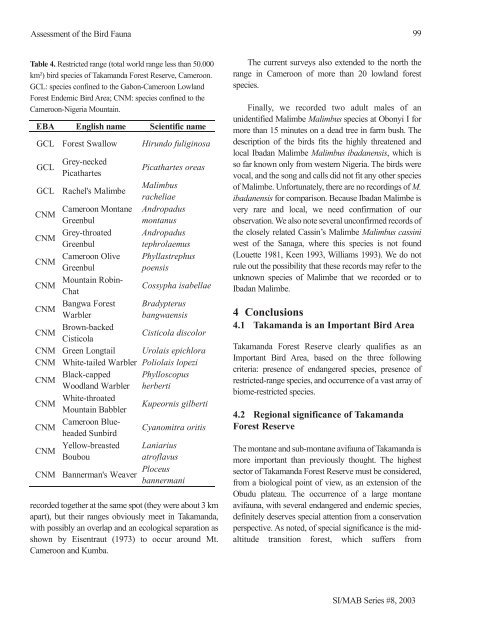Fisheries in the Southern Border Zone of Takamanda - Impact ...
Fisheries in the Southern Border Zone of Takamanda - Impact ...
Fisheries in the Southern Border Zone of Takamanda - Impact ...
You also want an ePaper? Increase the reach of your titles
YUMPU automatically turns print PDFs into web optimized ePapers that Google loves.
Assessment <strong>of</strong> <strong>the</strong> Bird Fauna<br />
Table 4. Restricted range (total world range less than 50.000<br />
km²) bird species <strong>of</strong> <strong>Takamanda</strong> Forest Reserve, Cameroon.<br />
GCL: species conf<strong>in</strong>ed to <strong>the</strong> Gabon-Cameroon Lowland<br />
Forest Endemic Bird Area; CNM: species conf<strong>in</strong>ed to <strong>the</strong><br />
Cameroon-Nigeria Mounta<strong>in</strong>.<br />
EBA English name Scientific name<br />
GCL Forest Swallow Hirundo fulig<strong>in</strong>osa<br />
GCL Grey-necked<br />
Picathartes<br />
GCL Rachel©s Malimbe<br />
CNM<br />
Cameroon Montane<br />
Greenbul<br />
CNM Grey-throated<br />
Greenbul<br />
CNM<br />
Cameroon Olive<br />
Greenbul<br />
CNM<br />
Mounta<strong>in</strong> Rob<strong>in</strong>-<br />
Chat<br />
CNM<br />
Bangwa Forest<br />
Warbler<br />
CNM Brown-backed<br />
Cisticola<br />
Picathartes oreas<br />
Malimbus<br />
racheliae<br />
Andropadus<br />
montanus<br />
Andropadus<br />
tephrolaemus<br />
Phyllastrephus<br />
poensis<br />
Cossypha isabellae<br />
Bradypterus<br />
bangwaensis<br />
Cisticola discolor<br />
CNM Green Longtail Urolais epichlora<br />
CNM White-tailed Warbler Poliolais lopezi<br />
CNM Black-capped<br />
Woodland Warbler<br />
Phylloscopus<br />
herberti<br />
CNM White-throated<br />
Mounta<strong>in</strong> Babbler<br />
Kupeornis gilberti<br />
CNM<br />
Cameroon Blueheaded<br />
Sunbird<br />
Cyanomitra oritis<br />
CNM Yellow-breasted<br />
Boubou<br />
Laniarius<br />
atr<strong>of</strong>lavus<br />
CNM Bannerman©s Weaver Ploceus<br />
bannermani<br />
recorded toge<strong>the</strong>r at <strong>the</strong> same spot (<strong>the</strong>y were about 3 km<br />
apart), but <strong>the</strong>ir ranges obviously meet <strong>in</strong> <strong>Takamanda</strong>,<br />
with possibly an overlap and an ecological separation as<br />
shown by Eisentraut (1973) to occur around Mt.<br />
Cameroon and Kumba.<br />
The current surveys also extended to <strong>the</strong> north <strong>the</strong><br />
range <strong>in</strong> Cameroon <strong>of</strong> more than 20 lowland forest<br />
species.<br />
F<strong>in</strong>ally, we recorded two adult males <strong>of</strong> an<br />
unidentified Malimbe Malimbus species at Obonyi I for<br />
more than 15 m<strong>in</strong>utes on a dead tree <strong>in</strong> farm bush. The<br />
description <strong>of</strong> <strong>the</strong> birds fits <strong>the</strong> highly threatened and<br />
local Ibadan Malimbe Malimbus ibadanensis, which is<br />
so far known only from western Nigeria. The birds were<br />
vocal, and <strong>the</strong> song and calls did not fit any o<strong>the</strong>r species<br />
<strong>of</strong> Malimbe. Unfortunately, <strong>the</strong>re are no record<strong>in</strong>gs <strong>of</strong> M.<br />
ibadanensis for comparison. Because Ibadan Malimbe is<br />
very rare and local, we need confirmation <strong>of</strong> our<br />
observation. We also note several unconfirmed records <strong>of</strong><br />
<strong>the</strong> closely related Cass<strong>in</strong>’s Malimbe Malimbus cass<strong>in</strong>i<br />
west <strong>of</strong> <strong>the</strong> Sanaga, where this species is not found<br />
(Louette 1981, Keen 1993, Williams 1993). We do not<br />
rule out <strong>the</strong> possibility that <strong>the</strong>se records may refer to <strong>the</strong><br />
unknown species <strong>of</strong> Malimbe that we recorded or to<br />
Ibadan Malimbe.<br />
4 Conclusions<br />
4.1 <strong>Takamanda</strong> is an Important Bird Area<br />
<strong>Takamanda</strong> Forest Reserve clearly qualifies as an<br />
Important Bird Area, based on <strong>the</strong> three follow<strong>in</strong>g<br />
criteria: presence <strong>of</strong> endangered species, presence <strong>of</strong><br />
restricted-range species, and occurrence <strong>of</strong> a vast array <strong>of</strong><br />
biome-restricted species.<br />
4.2 Regional significance <strong>of</strong> <strong>Takamanda</strong><br />
Forest Reserve<br />
The montane and sub-montane avifauna <strong>of</strong> <strong>Takamanda</strong> is<br />
more important than previously thought. The highest<br />
sector <strong>of</strong> <strong>Takamanda</strong> Forest Reserve must be considered,<br />
from a biological po<strong>in</strong>t <strong>of</strong> view, as an extension <strong>of</strong> <strong>the</strong><br />
Obudu plateau. The occurrence <strong>of</strong> a large montane<br />
avifauna, with several endangered and endemic species,<br />
def<strong>in</strong>itely deserves special attention from a conservation<br />
perspective. As noted, <strong>of</strong> special significance is <strong>the</strong> midaltitude<br />
transition forest, which suffers from<br />
SI/MAB Series #8, 2003<br />
99

















